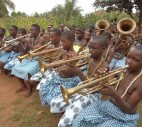Music is everywhere at SFS: at the center of school ceremonies, animating school plays, drifting down the halls, and sung spontaneously by children as they work in the classrooms or play in the yard.
What would it be like to sing any music you hear? And in tune? To be able to figure out how to play anything you can sing? And then create an accompaniment, improvise variations, and choreograph a dance to it? Welcome to the world of Orff Schulwerk!
Children at The San Francisco School know a hundred songs to comfort and energize themselves, dozens of dances, lots of pieces played in ensemble on the Orff instruments. Not only can they duplicate great music and dance, but they can also create their own. In the Orff approach, music is a verb, constantly in action, fluid, flexible.
As music teachers, we are responsible for teaching the particular craft of how to artfully combine sounds and movement. Children leave our school with a solid foundation from which to pursue any musical study, from Samba to Stravinsky to Sonny Rollins. We aim to create a musical culture in which every child—and many adults as well— participates joyfully and confidently.
Come hear for yourself! And for more details on our music program by grade, see the Curriculum Guide.




